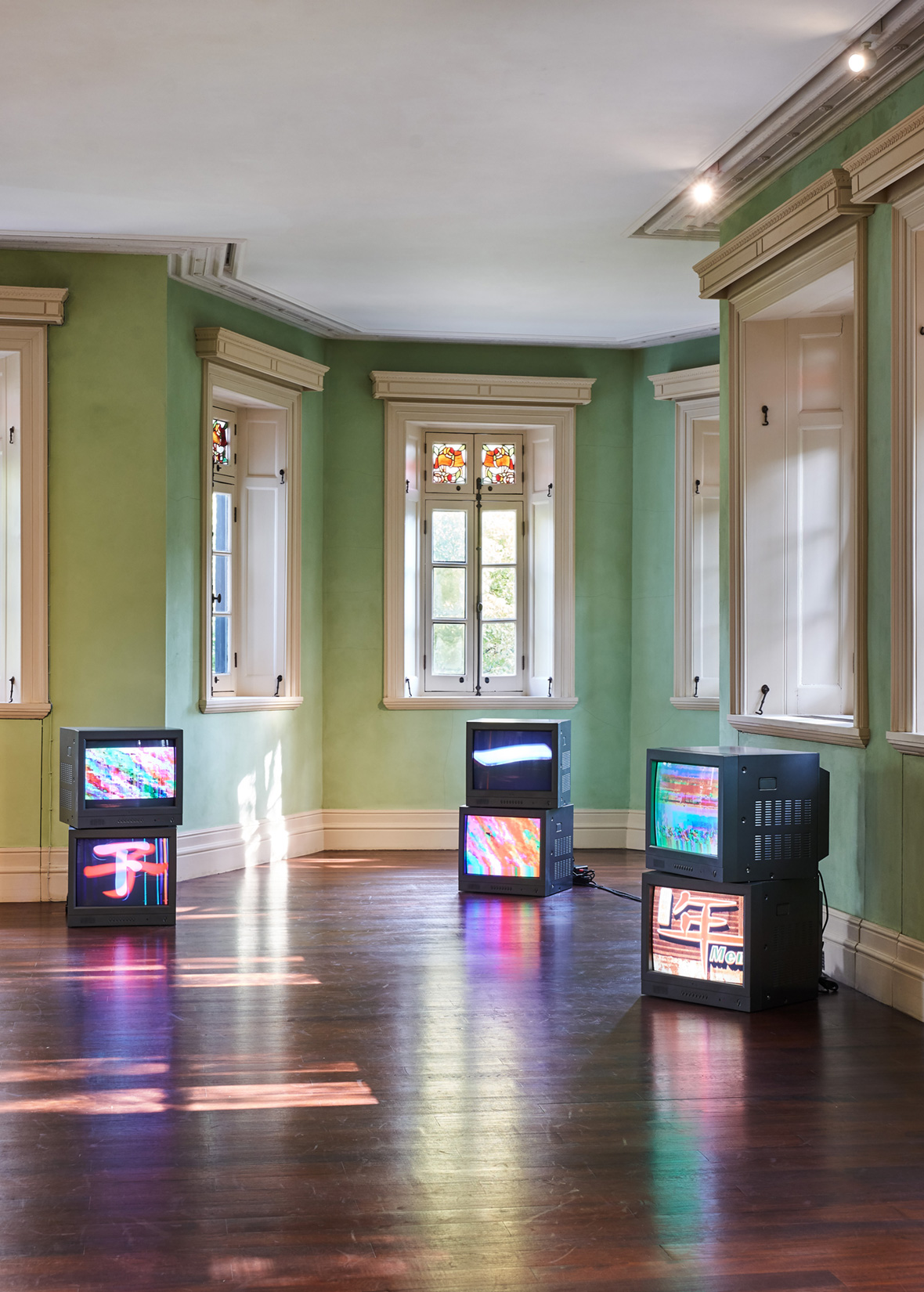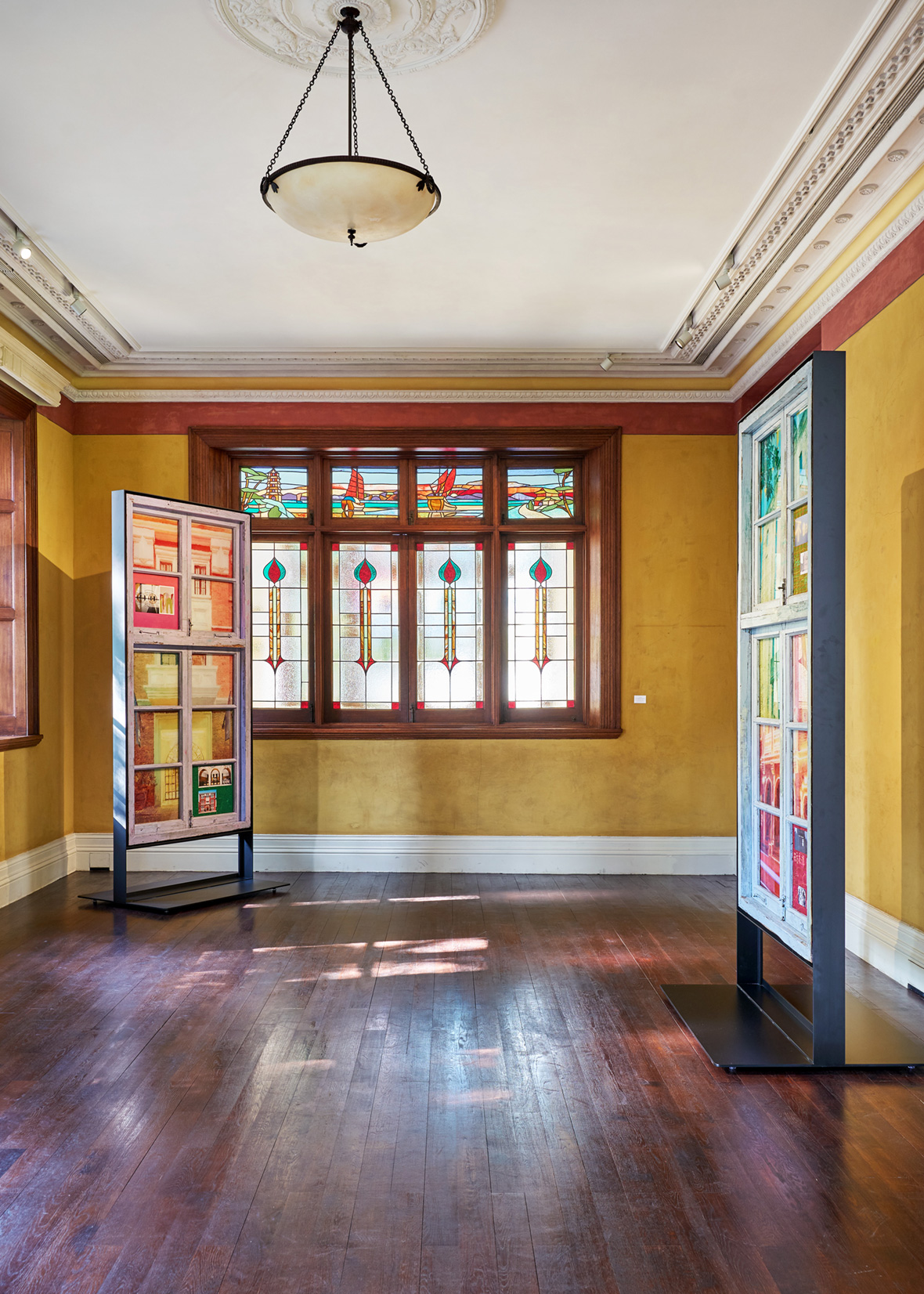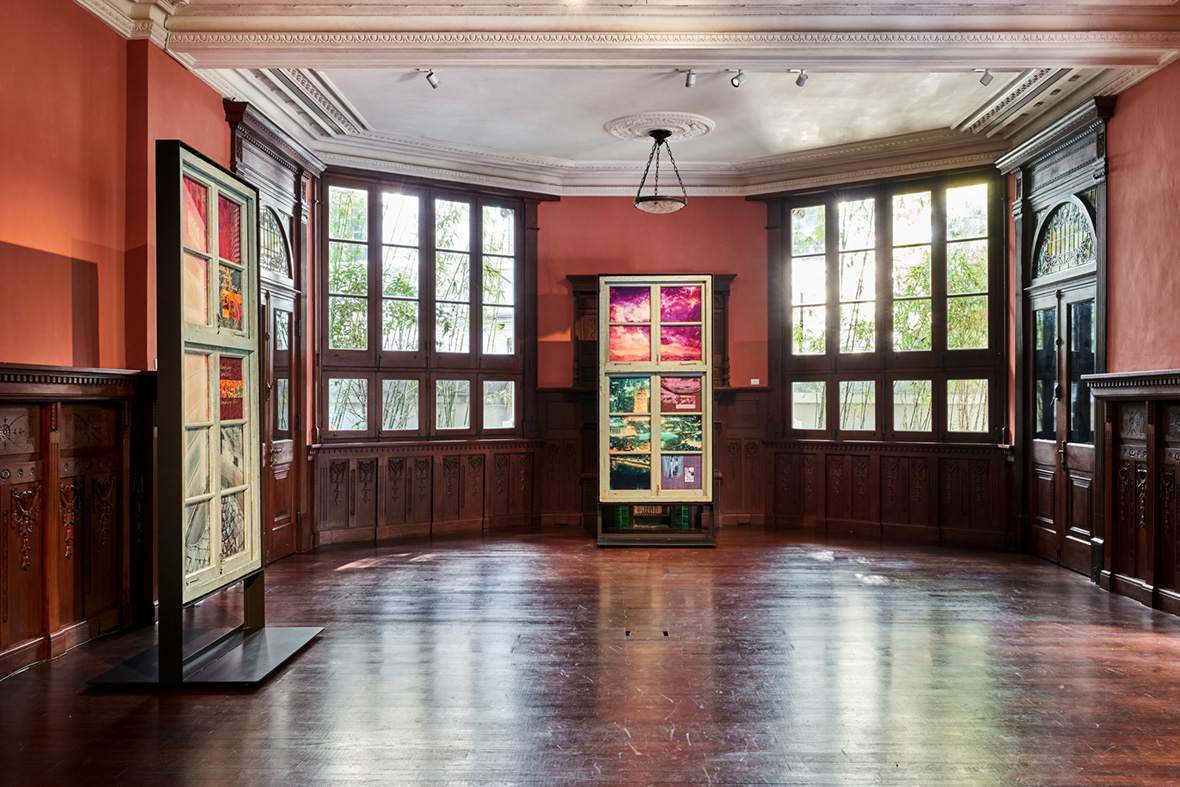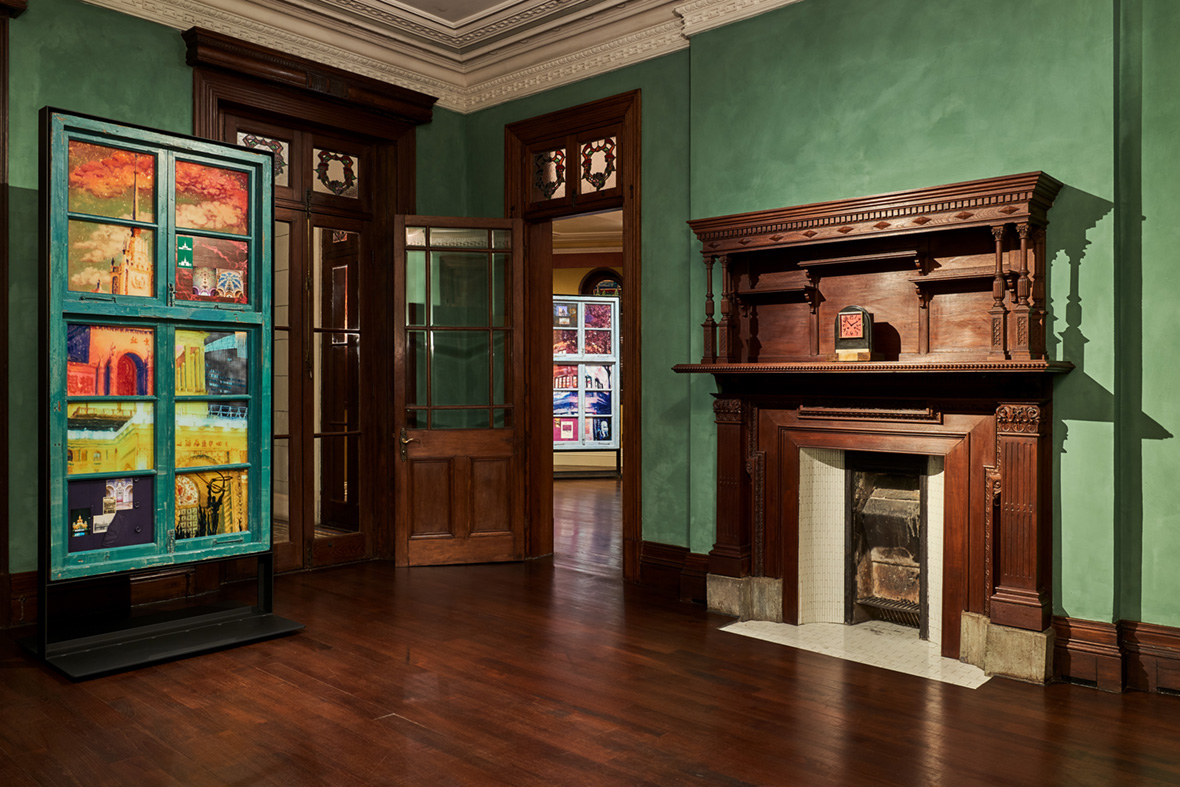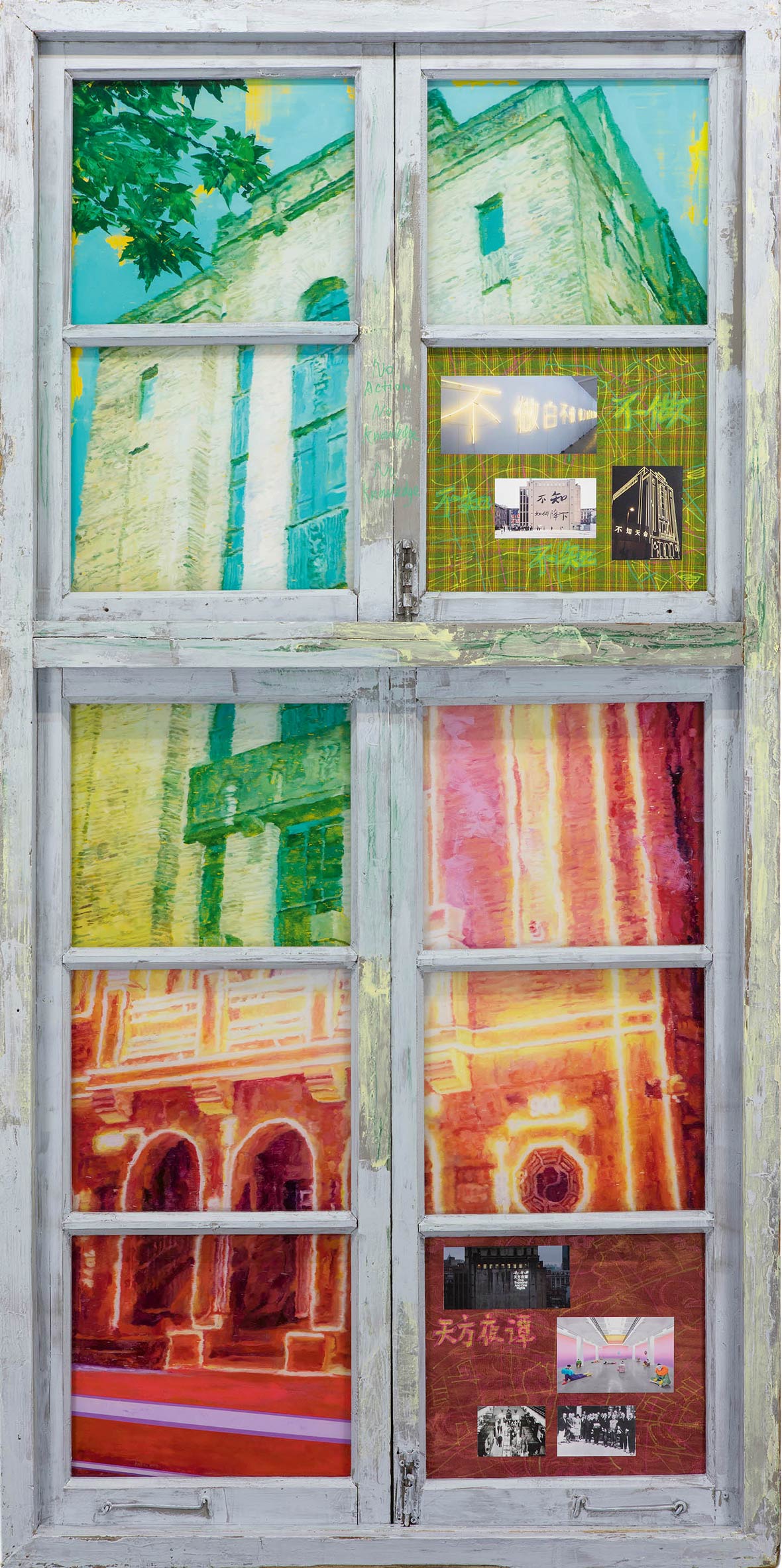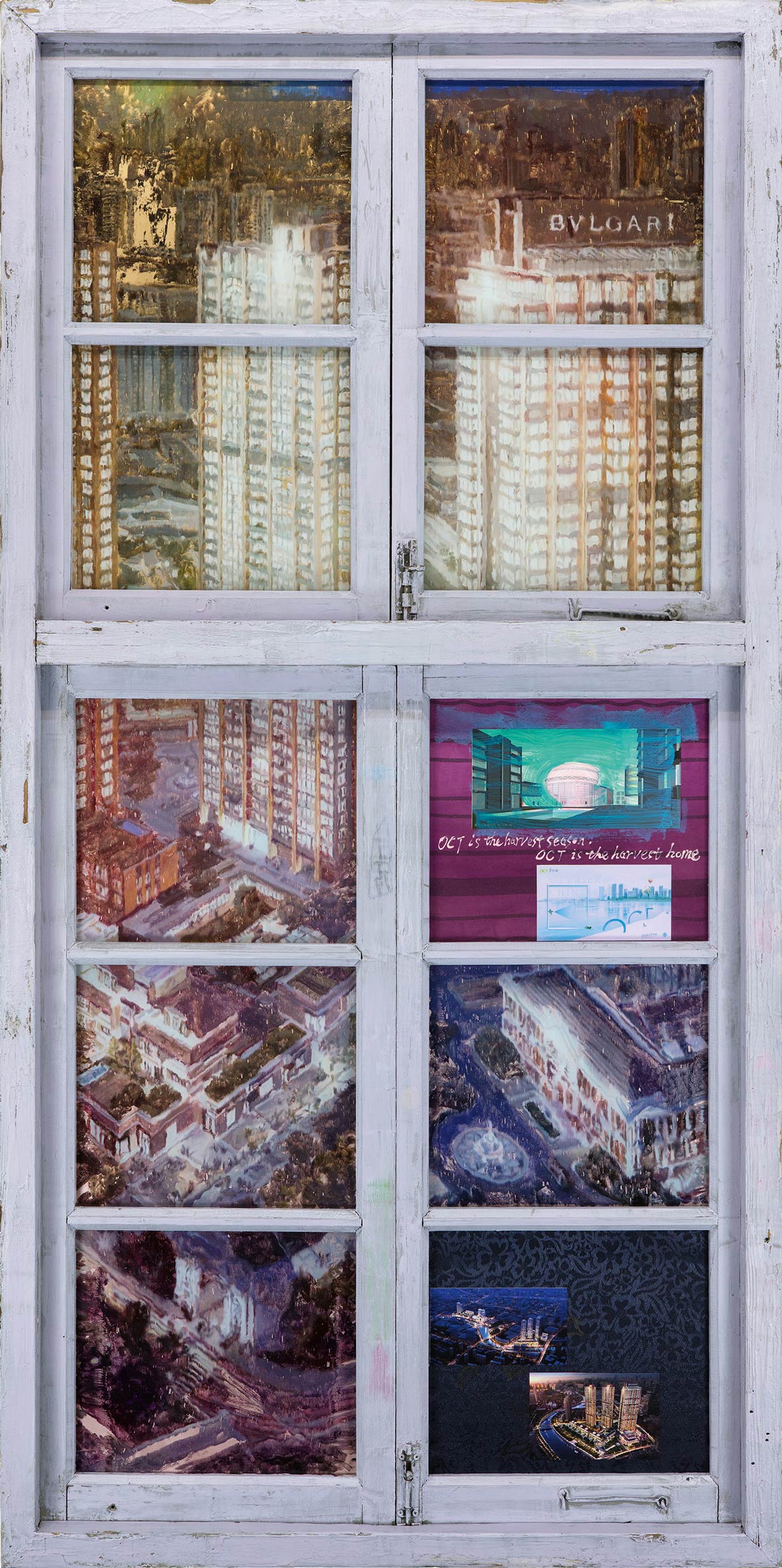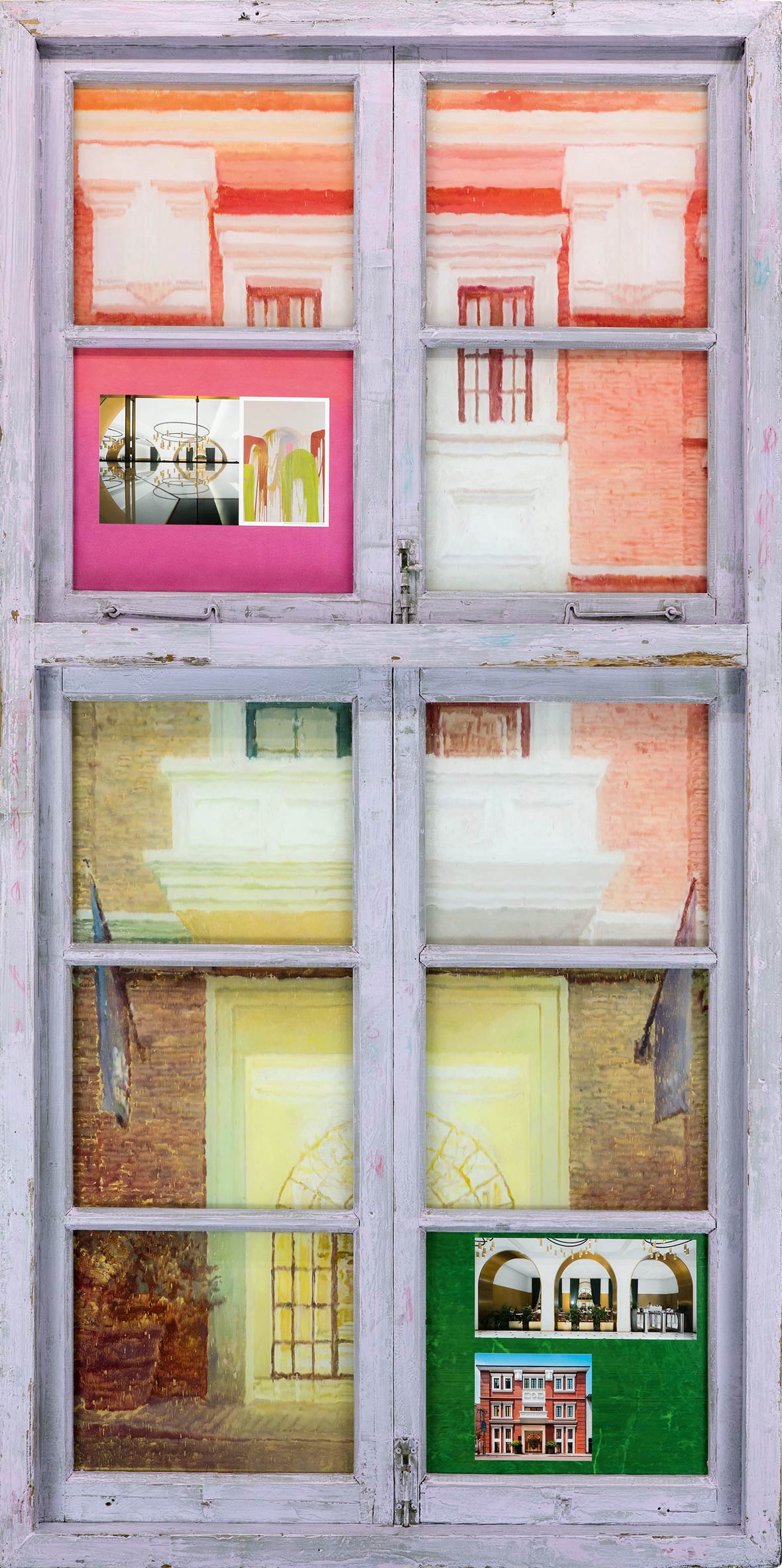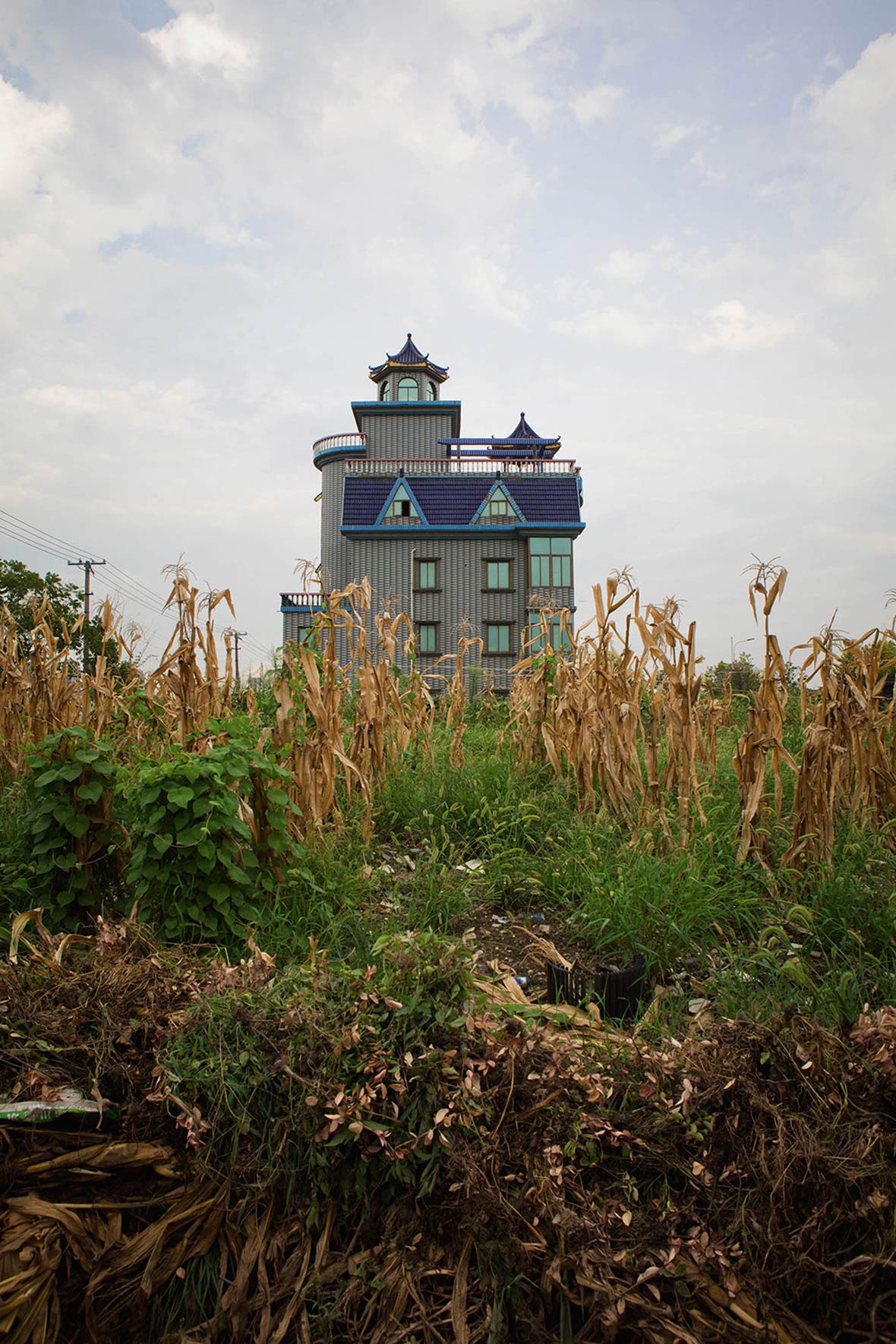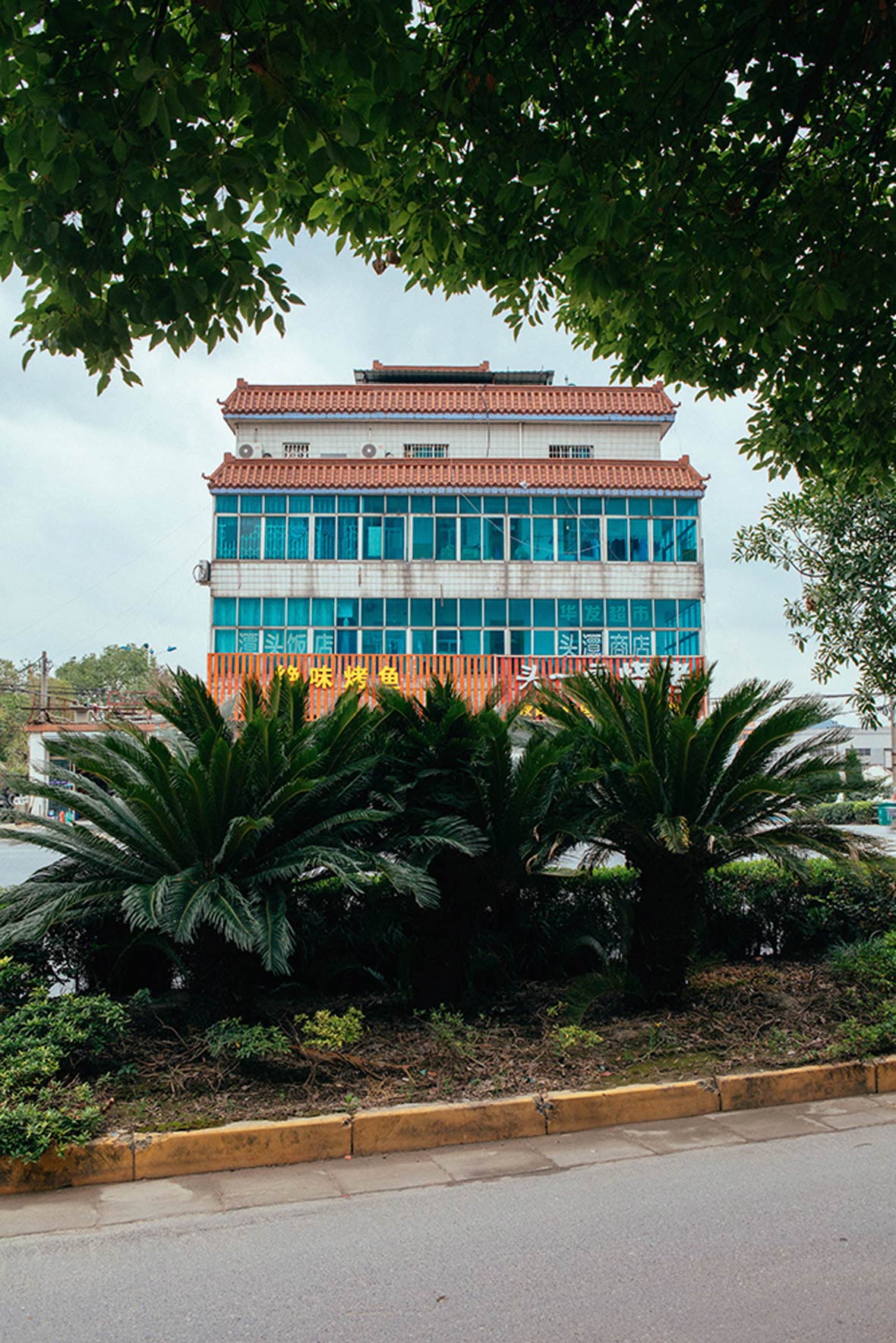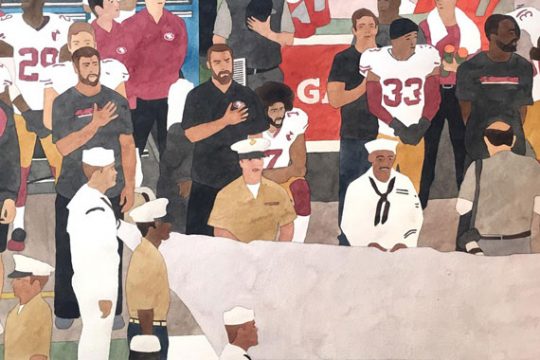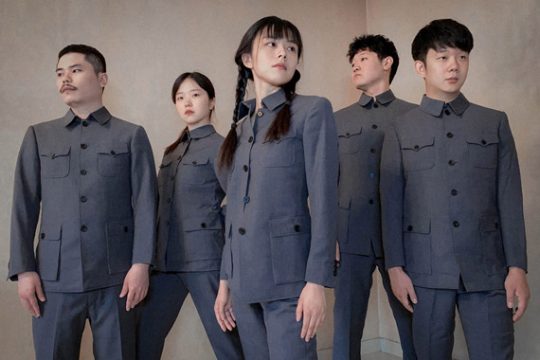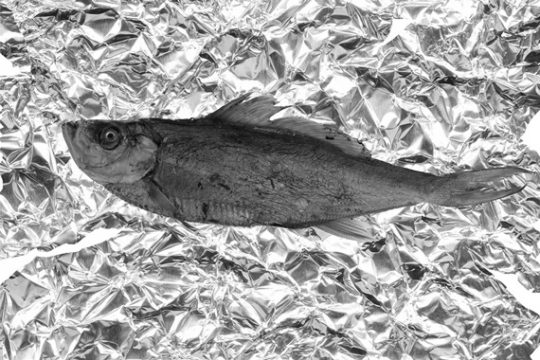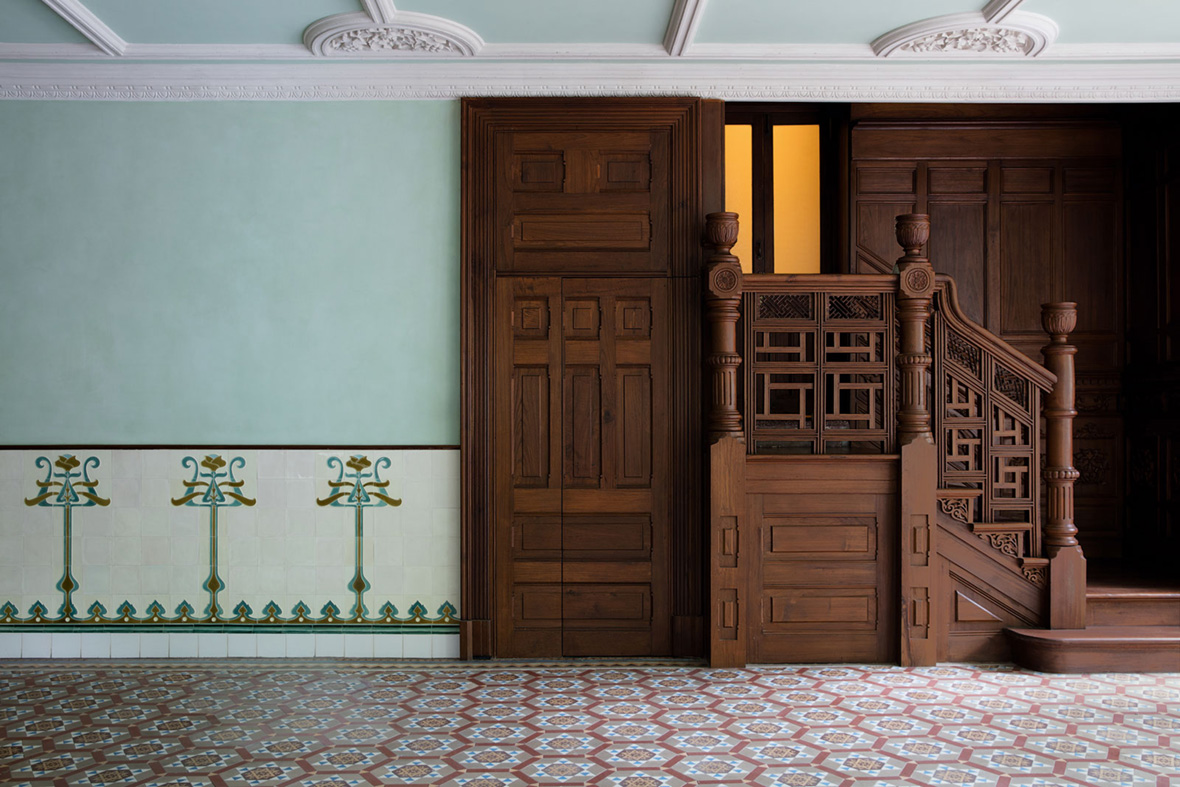
Outside the window, in Shanghai’s busiest shopping district, North Shaanxi Road buzzes with activity; but inside the sunlit salon, silence reigns over the ornate wooden staircase and artwork-covered walls. You’d almost think you’d stepped a century back in time to the age of Shanghai’s gilded splendor. Look closely, though, and a few incongruous details—paintings of modern cityscapes set inside a window frame; television screens flashing a single character at a time; and a KTV room playing a retro hit, its video oddly scrubbed of people—tip you off that you’re in an exhibition space.
This is Prada Rong Zhai, the site of artist Li Qing’s exhibition Rear Windows.
窗外是街,是全上海最繁华的商业地段,一条车水马龙的街;而窗内是静谧的木楼梯、洒满阳光的大房间和挂了满墙的画。你不会觉得这里是一个展厅,反而更像是步入了百十年前鎏金的上海岁月——但仔细看,旧窗框切割了油画的街景,电视机播放着单个的文字,小包厢里放映的怀旧金曲,MV 也被替换成了无人的空镜。
这里是 PRADA 荣宅,艺术家李青“后窗”的展览现场。
Li came up with the idea to use windows as a medium while searching for different ways to approach contemporary painting. He noticed that windows framed scenery much like a camera’s viewfinder, and on certain types of windows, glass panes divided up a scene into multiple compositions. By placing scenes inside of old window frames, they were imbued with an immersive realism.
As Li’s art evolved, the windows that appear in his work have taken on new meaning. In a way, they’re bearers of history. Not only do they evoke a sense of familiarity, the windows of a building can be also understood as a testament to the structure’s past and present.
“窗”这个媒介,最初是李青在思考“绘画的再现”这个过程时想到的。把绘画和真实的窗框相结合,较之普通的绘画视角,更具有真实的代入感。它像一个自然的“取景框”,把图像纳入其中,风景就被动分割开来。
随着创作的推进,李青拿来做作品的旧窗框展现了更重要的意义:窗,作为一个日常的建筑景观,本身就包含着时光的印记,每一个人的生活都与它存在着关联。
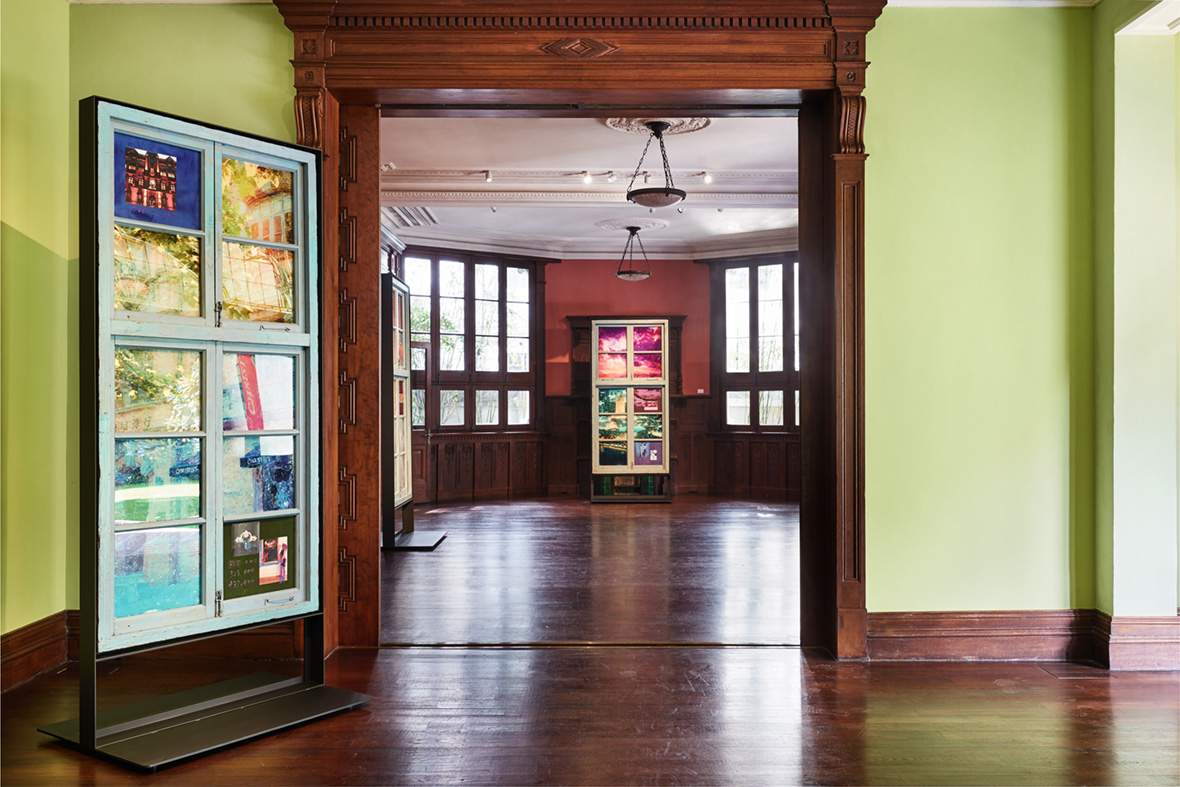
This meditation on the past and the present is at the core of Li’s Tetris Windows, one of the most noteworthy series of the exhibition. Mounted within antique window frames, Li’s paintings center on the historic architecture of Shanghai. Unlike past works, select panes have been replaced with multimedia collages of text, photos, and other materials. These additions draw attention to the changes that each building has undergone over the years, hinting at a larger narrative of how a city’s growth can have a lasting impact on local culture and lifestyle. This idea of time and change is also evident in the paintings themselves, which depict the same scene at different times of the day. Certain sections radiate with the glow of the early-afternoon sun while other sections are drenched with the indigo hues of dusk. Through these ambitious concepts and approaches, Li’s windows have become more than just an aesthetic device—they offer unique glimpses into the artist’s worldview.
Rear Windows shares similarities with Hitchcock’s eponymous film in that they’re both designed to show only what the artist wants the audience to see. The exhibition, through jarring contrasts between old and new, is designed to influence viewer perception, Li says. In doing so, his work forges unlikely connections between windows, people, architecture, and city.
展览的核心之作当属李青的《迷窗》,李青用旧窗框作为作品的画框,透过其中呈现着上海这座城市的历史建筑。和过去的作品不太一样的是,最新的作品除绘画之外,李青还添加了拼贴画和文字,让人不禁对建筑经年的历史、城市的发展叙述,以及其对居民生活的影响,萌发了关注与好奇。李青这个系列的作品里,很多窗户里画着阳光明媚也画着华灯初上,仿佛涵盖了一整天的光景。在这样的语境下,“窗”已不是窗,而是成为一种观看的途径,以一窥艺术家李青眼中的世界。
“后窗”更像是希区柯克同名电影里所隐喻的窥探的“窗口”,在特定的区域内用新的结构来代替旧的结构,李青觉得,这是个“给定的路径,可以通过设立一定的屏障介入观众的观看”。至此,人与窗、窗与屋子、屋子与城市,就形成了某种微妙的关系。
Unlike typical galleries, with their sterile white walls, Rong Zhai feels lived in, a sensation that Li heightens in this show. In the ballroom, bedrooms, and music room, he places works that resonate with each space, inviting the viewer to question their relationship to the constantly changing world outside. A century-old colonial house converted to a nontraditional exhibition space or art gallery, says Li, “gives these works a fuller context, makes the art itself more diverse.”
与一般美术馆的“白盒子”空间不同,李青把荣宅想象和“改造”成一个仍有居住者存在的空间,他将舞厅、卧室、练歌房都配以不同的作品与之呼应,似是在邀请观众质疑与周遭不断变化的世界之间的关系。一栋拥有百年历史的老洋房,如今作为非传统意义的展厅或美术馆,李青觉得这反而“让作品的语境更饱满,让作品内在更多元”。
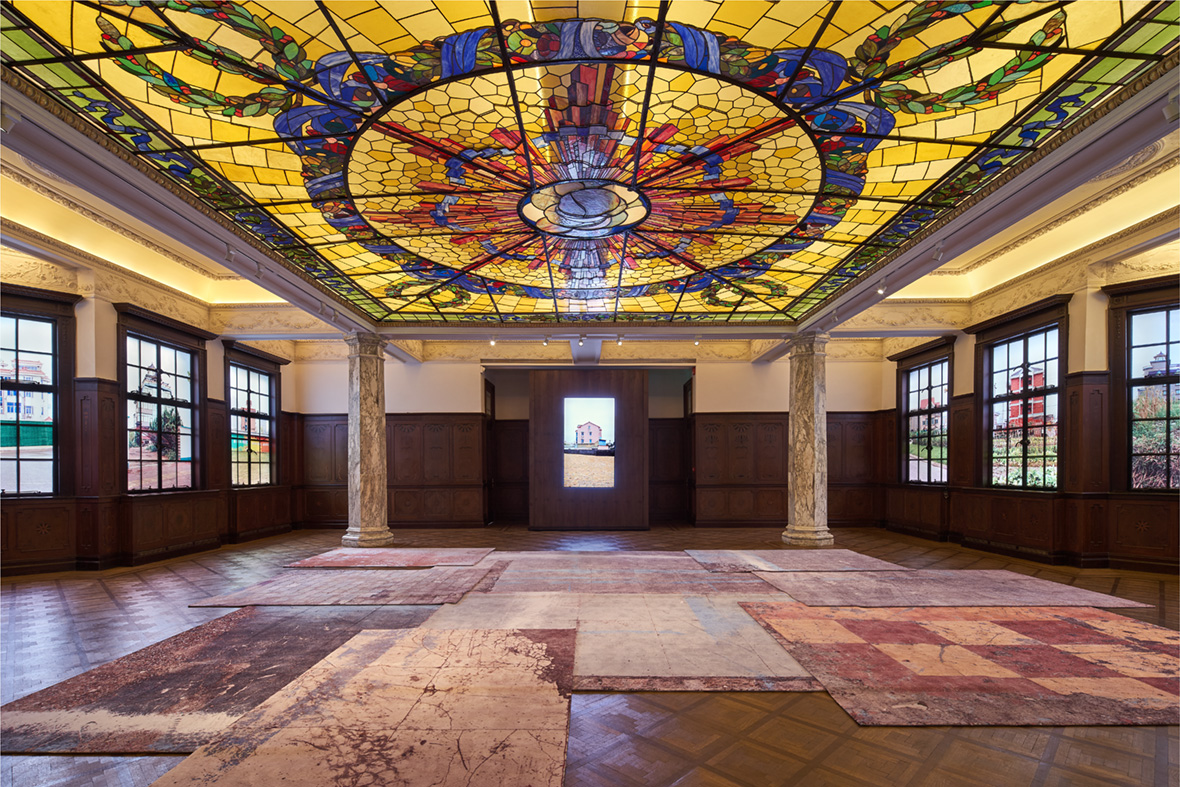
Take, for example, the grand ballroom, which was once used to host formal events and extravagant parties. In a gesture of irony, Li chose the space to display Things You Can Take Away and Hangzhou House Series. The former is a collection of carpets designed in the likeness of floor tiles found in old Hangzhou housing. In it, Li plays with the contrast between the soft comfort of rugs and the harsh imagery of scuffed tiles covered in dirt. Per the artist’s intent, these carpets are completely overshadowed by the glitzy stained-glass skylight overhead.
For Hangzhou House Series, Li covers the ballroom’s windows with photos of buildings in the Hangzhou suburbs. These houses were built based on the locals’ ideas of modern luxury, but they’re a far cry from the palatial estate that these photos are now showcased in.
以舞厅为例,这间曾被用作大型会客厅的大房间,李青现在其中呈现了两件作品,分别是《你可以带走的东西》和《杭州房子系列》。前者是一些地毯,这些地毯取自李青拍摄的杭州旧房屋拆除时遗留的地面,它们看似坚硬,不少带有裂痕,并有擦碰和灰的痕迹,但地毯的材质却是柔软和有温度的,这样形成了一种强烈的冲突性。按照艺术家的意图,这些不起眼的地毯完全被顶上的彩色玻璃天窗所遮盖。
而《杭州房子系列》则映在舞厅的窗户上,这是艺术家在老家杭州拍的郊区的自建房照片。这些房子按照当地人对“当代摩登”的理解而建造的,但事实上它们和真正的豪宅相去甚远。
With the presence of different time periods and urban cultures, the coexistence and combination of different viewpoints and ideologies, a dialogue begins between past and present, and a relationship is established between people and the city. And this is precisely what Li hopes to show through Rear Windows. “Everything is you see here,” he says, “is part of the show.”
Tickets are available via the Prada Rong Zhai WeChat Mini Program.
Exhibition:
Rear Windows
Dates:
Nov. 7th 2019 ~ Jan. 19th 2020
Address:
Prada Rong Zhai
186 North Shaanxi Road
Jing’an District, Shanghai
People’s Republic of China
不同时代和城市文化的不断延续,不同观念与意识形态的共存与交融,过去与现在之间的对话、城市与人之间的关联,就此开启。而这正是李青期望通过“后窗”去呈现的——“你能看到的一切,都是展览的一部分。”
前往 PRADA 荣宅的微信小程序 即可购票。
展览:
“后窗”
展期:
2019 年 11 月 7 日 ~ 2020 年 1 月 19 日
地址:
PRADA 荣宅
上海市静安区
陕西北路 186 号
中国

